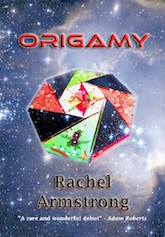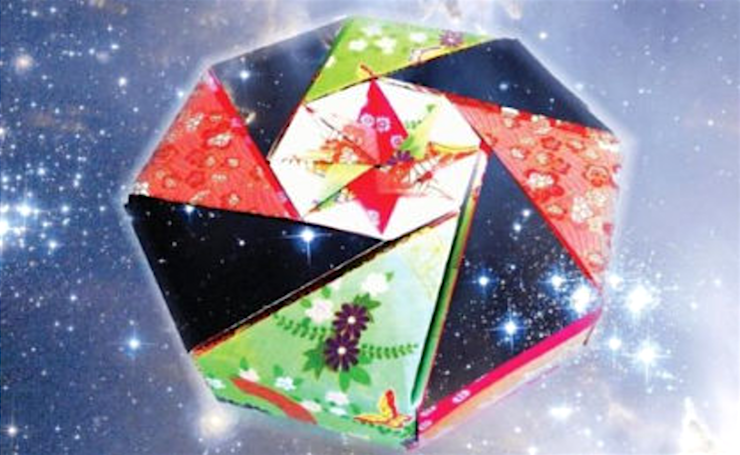How do you translate the transcendental into words on a page? Is there a way for enterprising writers to convey the way that a highly evolved being might move through time and space in a way that those of us who are merely human might comprehend? Sometimes prose can be at a disadvantage: consider the hallucinatory climax of the film 2001: A Space Odyssey, or the more reality-bending moments of the comic book The Invisibles. In her debut novel Origamy, Rachel Armstrong endeavors to do exactly this: writing from the perspective of someone who manipulates space and time the way that a potential reader might drive a car, bake a loaf of bread, or mold clay.
Mobius, the novel’s narrator, is part of “a culture of spacetime weavers,” as her mother Shelley tells her in one early interaction. What that amounts to in practical terms is an extended lifespan and abilities beyond the grasp of most; while the narrative is set in the future and is deeply science fictional in concept and execution, there’s also a sense of Mobius and her family as demigods of a sort. (Mobius’s father Newton, described as “a giant” with a hint of omnipresence, certainly feels like he could fit in to any number of pantheons in his spare time.) Mobius describes the title phrase as “[t]he artful and athletic practice of weaving spacetime fabrics to discover outlandish places and events.” In other words, a blend of life, gaming, and evolution–constant adaptation to changing circumstances is part of this way of life.
Buy the Book


Origamy
As the novel begins, Mobius has lost some of her memory; much of the book concerns her taking an expedition through time and space and re-learning certain skills essential to this practice. This leads her across the cosmos, using a pair of chopsticks as the tools of her trade. Or, as Mobius herself describes it:
“The chopsticks enable me to see events taking place at the nanoscale, so that I can grab hold of subatomic particles traveling at the speed of light. All I have to do is remember how to observe the telltale signs of drifting spacetime fibres.”
There are plenty of scenes like this, moments in which the navigation of multiple dimensions of reality are conveyed through a blend of the familiar and the bizarre. There are also quietly charming notes on the future of humanity: at one point, Mobius ponders the ways in which Heinz’s “57 Varieties” has evolved into a culture-wide symbol of luck many years from now. That juxtaposition is representative of the novel as a whole: at times, the onrush of ideas is enough to carry things forward; at others, the uncannily familiar shows up in unexpected places.
Mind you, Origamy is also a difficult book to review in full, because to explore some of the thematic payoff for certain elements introduced early on in the narrative would be to spoil large chunks of things. Suffice it to say, the novel’s first half includes a host of big ideas about evolution, some occasionally unsettling imagery involving various fauna that Mobius encounters on her journeys, and a host of musings on questions of symbiosis and biological interconnectedness. By the end of Origamy, all of these will have paid off in a decidedly visceral fashion—but it’s also far removed from the quirkiness of the early scenes of family and navigation of reality itself.
At times, the progression of Origamy can feel somewhat episodic, as Mobius moves from world to world, dealing with assorted threats to herself and to space and time, musing on the potential hazards inherent in origamy, and pondering her own gaps in memory. There’s a threat hanging over the proceedings—“fanatical creatures that inhabit the dark universes which do not share our ethics,” as Shelley tells Mobius—and at times the juxtaposition between this overarching conflict and Mobius’s more internal ones creates a sort of dissonance.
That said, the presence of a copy of Italo Calvino’s Invisible Cities in one scene suggests that the episodic nature of much of the novel is entirely intentional—a way for Armstrong, who is no stranger to big ideas, to explore a host of heady concepts over the course of the narrative. The concepts, images, and settings found in this novel could easily power a quartet of more traditionally-arranged works; instead, the madcap energy here is another essential part of the narrative. Early in the novel, Mobius asks Shelley if their family is “a circus troupe”—and that image helps inform much of what follows.
Finding a reference point for Origamy isn’t easy—the closest I could think of was Jennifer Marie Brissett’s Elysium, in that both blend high concepts with narratively gripping approaches to conveying action that nonetheless defies easy description. There are ideas and images in Armstrong’s novel that are hard to forget. As with Mobius’s journey through the cosmos, not every avenue this narrative explores entirely clicks, but those that do showcase a powerful approach to storytelling and a welcome penchant for innovation.
Origamy is available from NewCon Press.
 Tobias Carroll is the managing editor of Vol.1 Brooklyn. He is the author of the short story collection Transitory (Civil Coping Mechanisms) and the novel Reel (Rare Bird Books).
Tobias Carroll is the managing editor of Vol.1 Brooklyn. He is the author of the short story collection Transitory (Civil Coping Mechanisms) and the novel Reel (Rare Bird Books).










